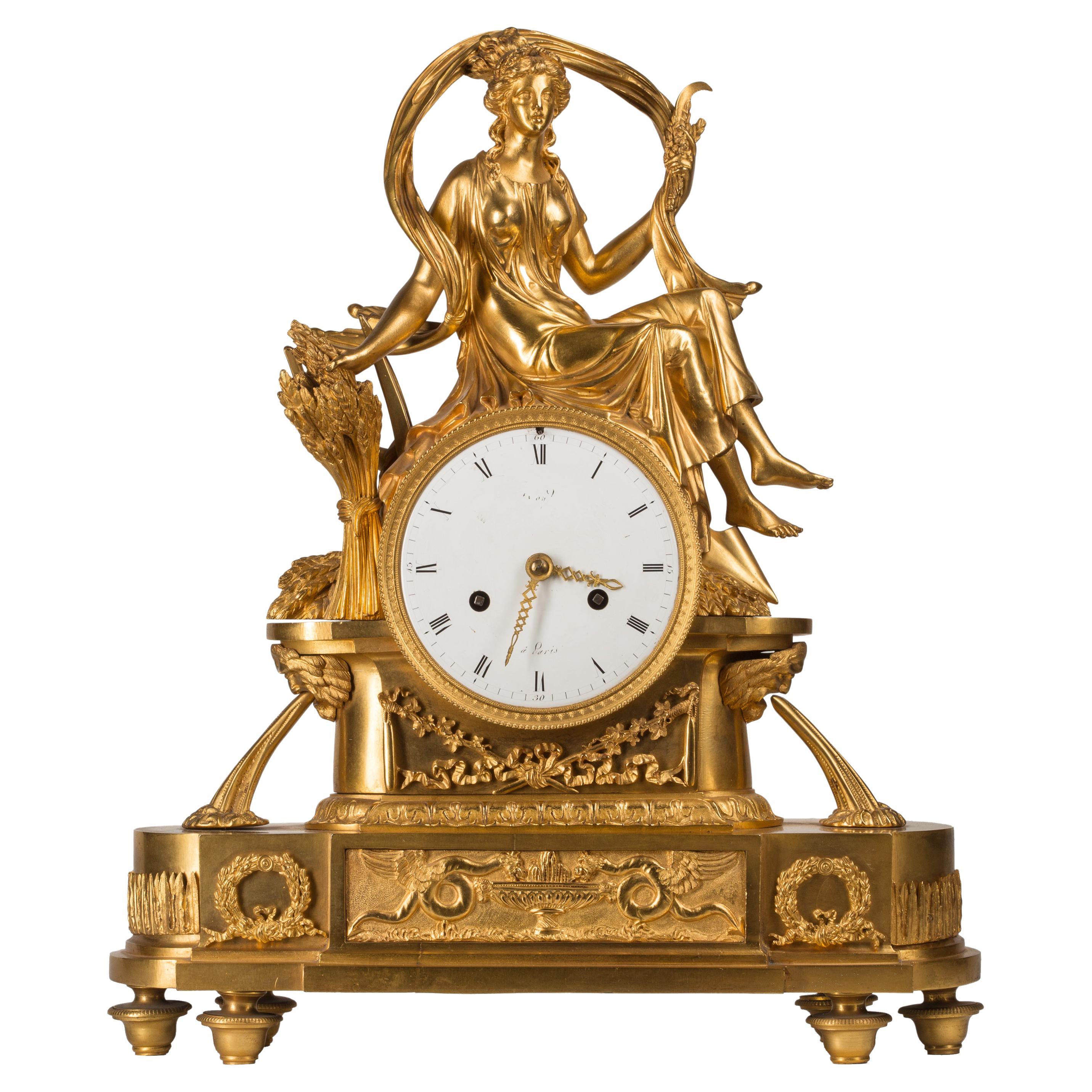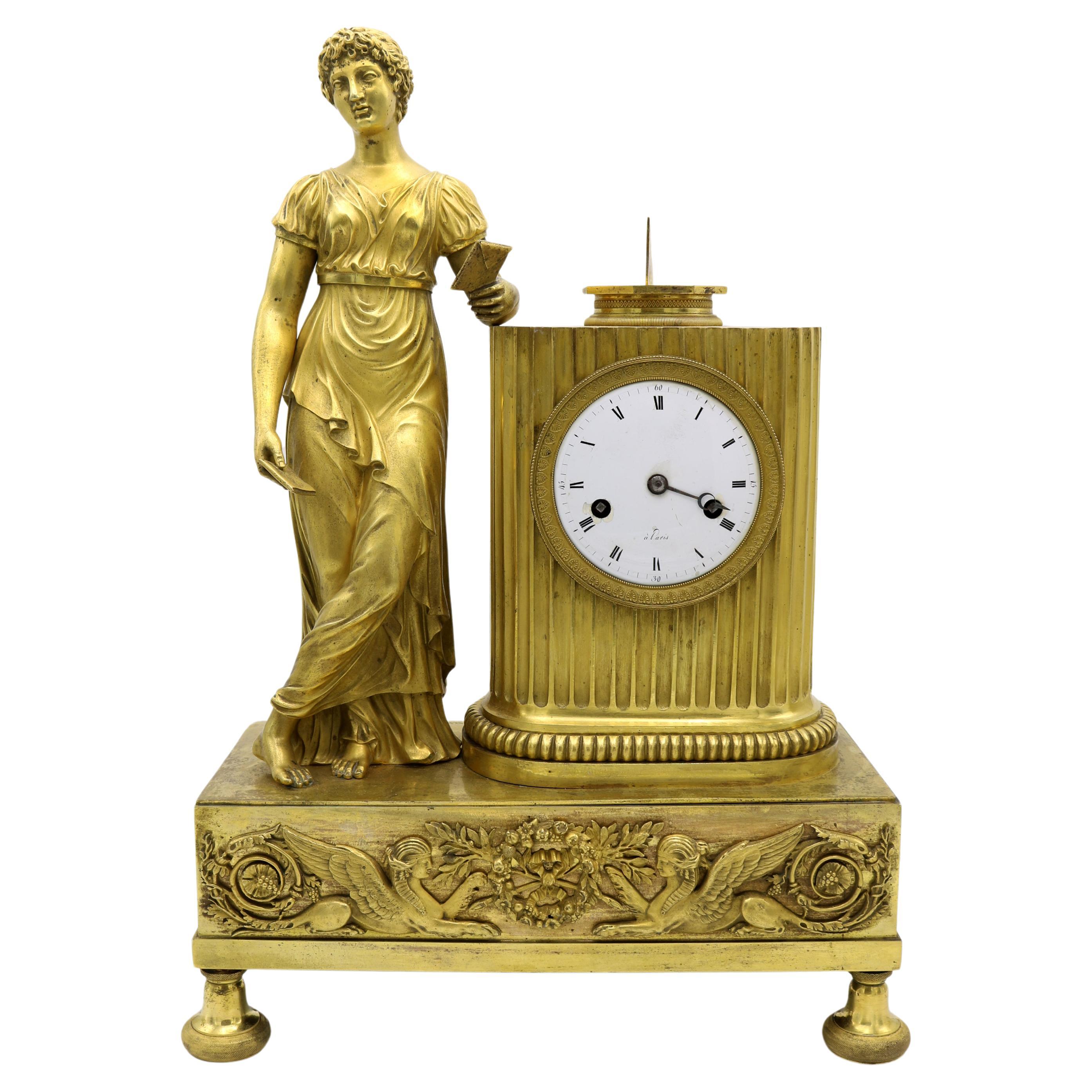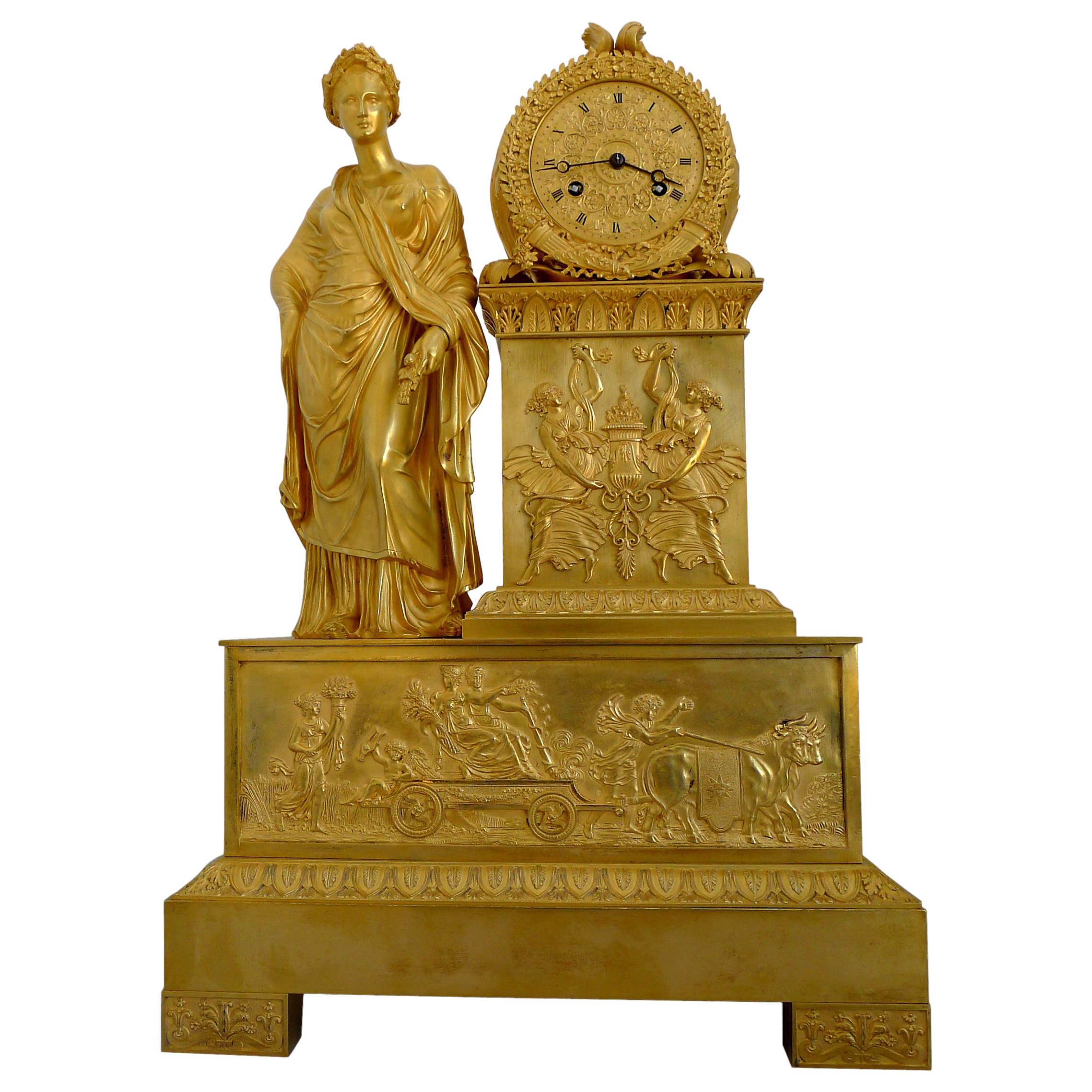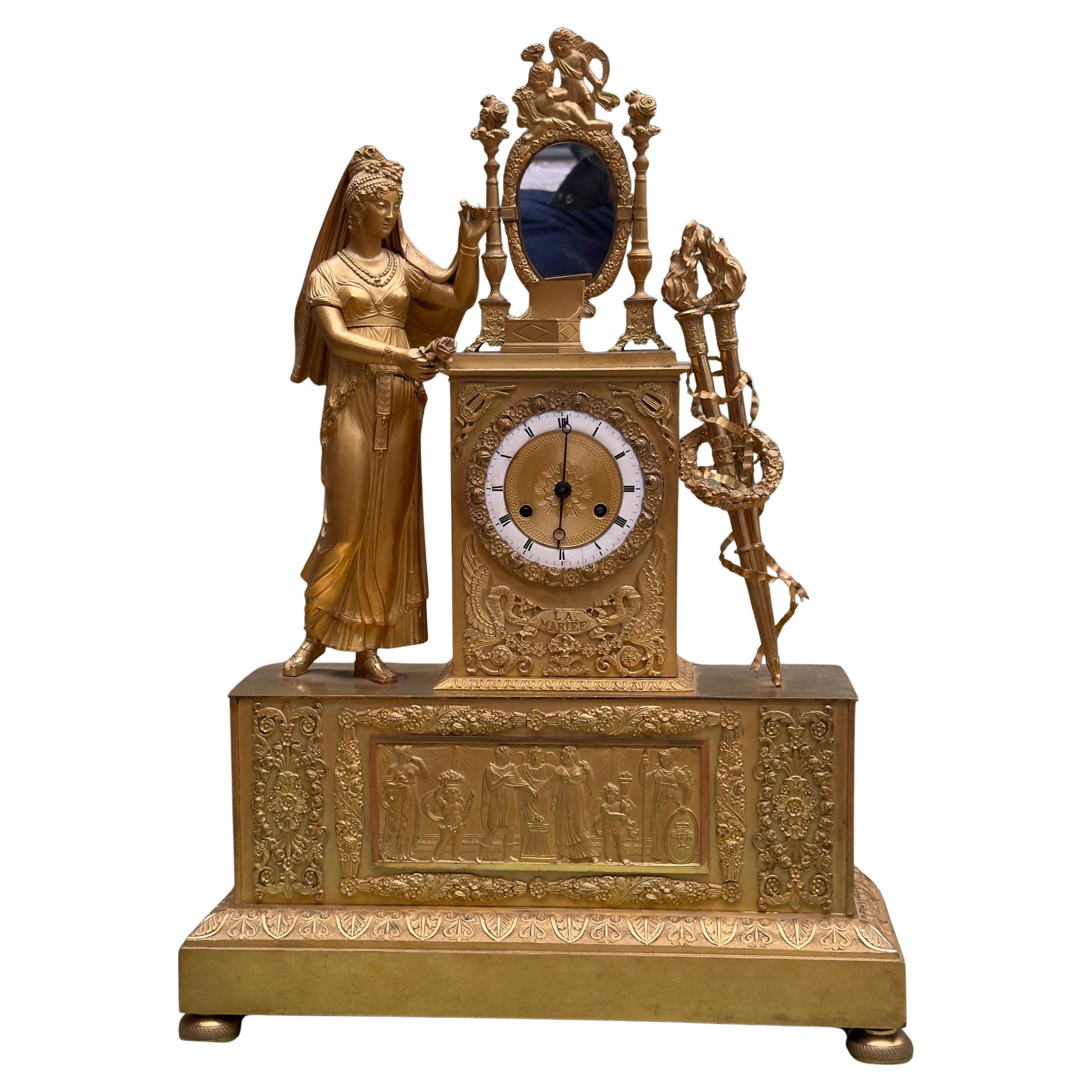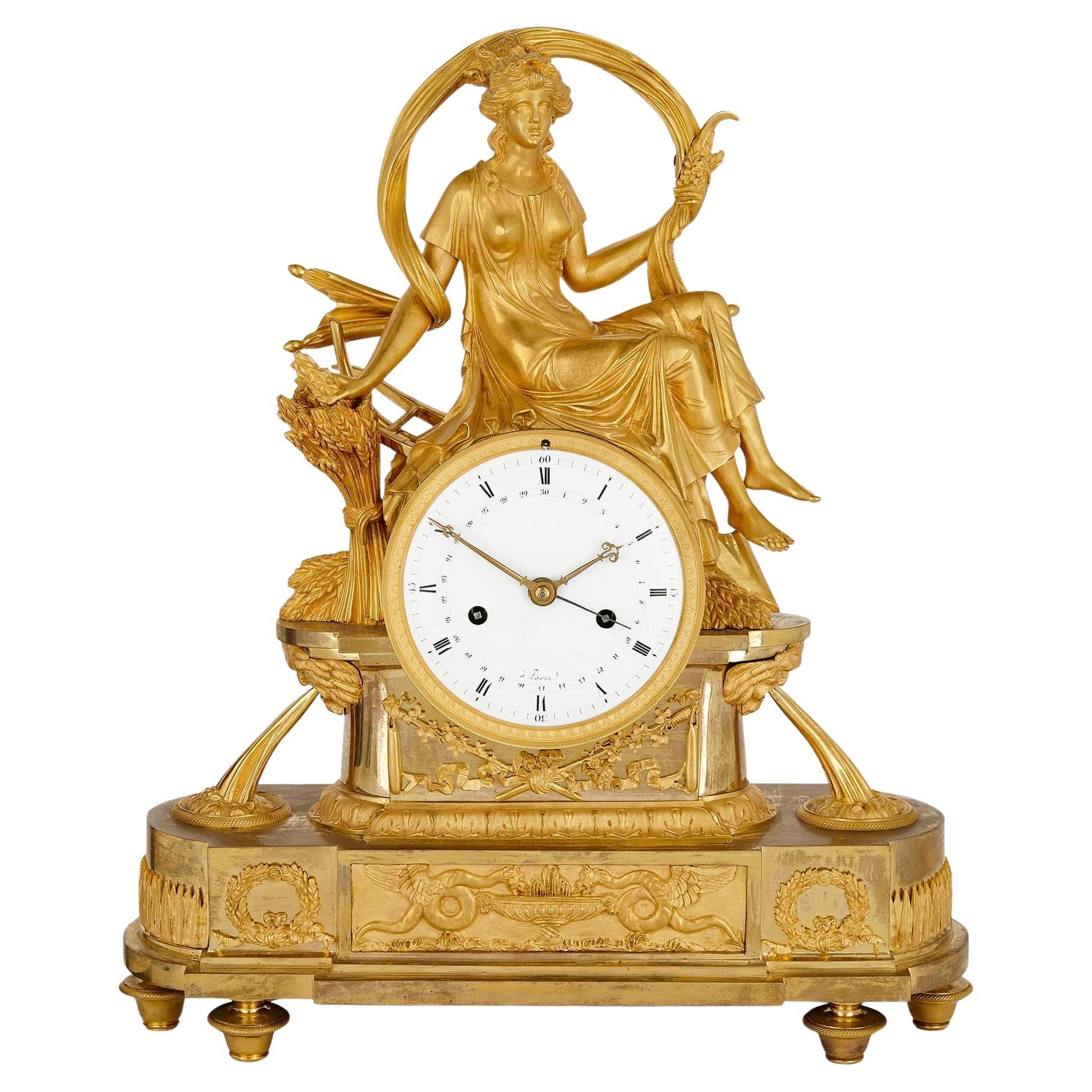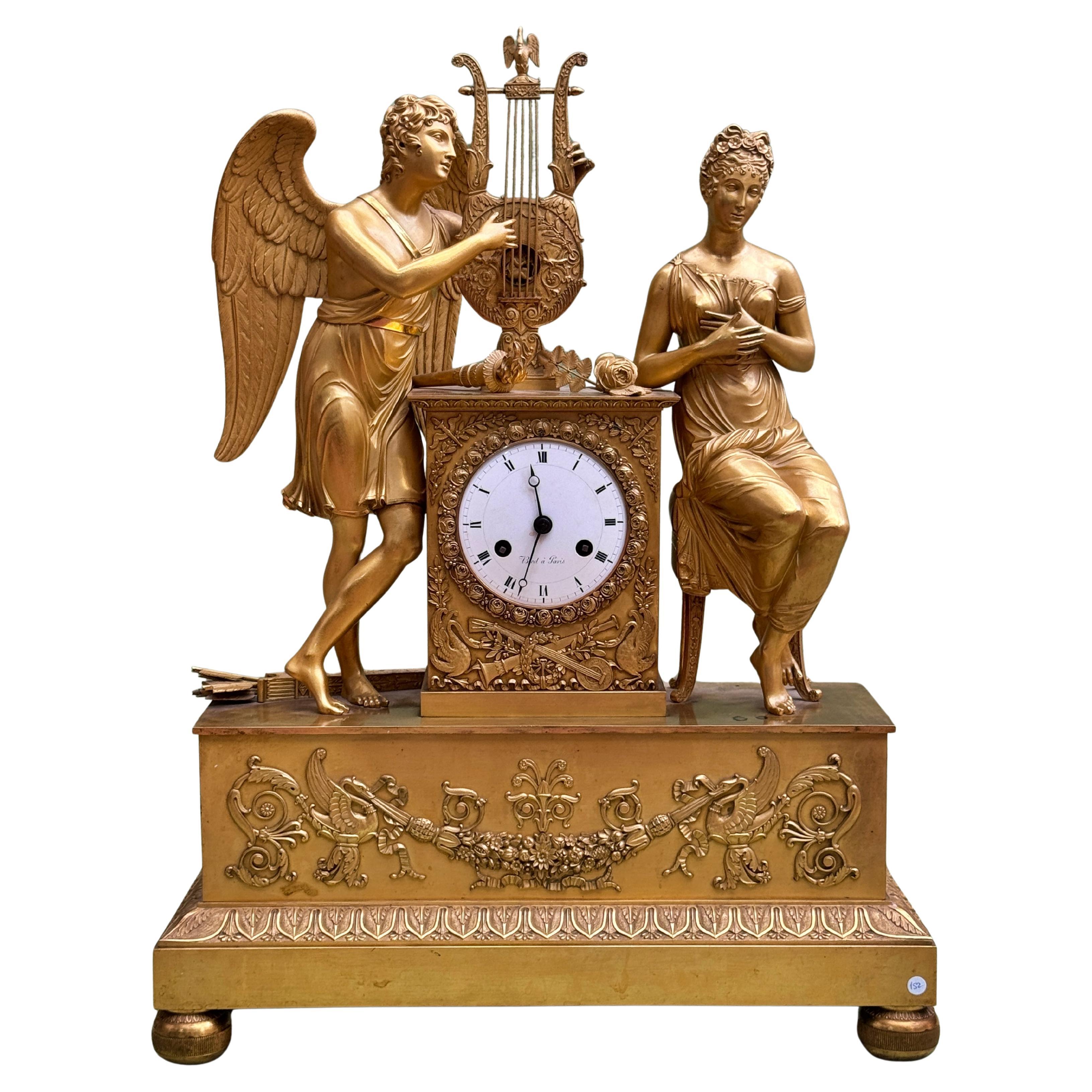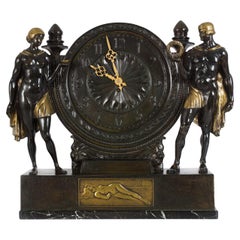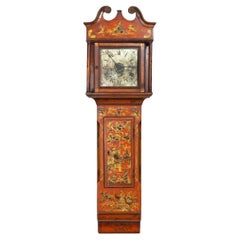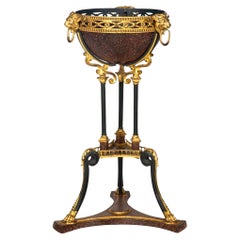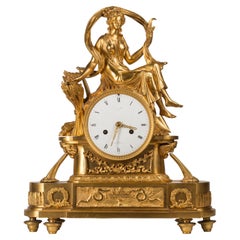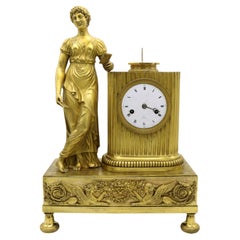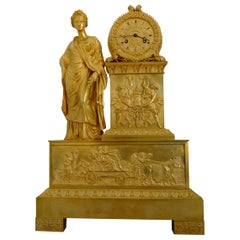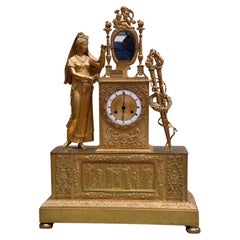Items Similar to French Empire Period Ormolu Bronze Mantel Clock of Ceres, circa 1815
Want more images or videos?
Request additional images or videos from the seller
1 of 21
French Empire Period Ormolu Bronze Mantel Clock of Ceres, circa 1815
$3,850
£2,971.36
€3,382.72
CA$5,497.47
A$5,996.06
CHF 3,159.41
MX$71,908.77
NOK 39,781.04
SEK 37,114.91
DKK 25,262.96
About the Item
A fine Empire period mantel clock with bun feet raising a rectangular base with a central portrait of Bacchus flanked by exquisitely chiseled motif of swirling foliage surmounted by a figure of the goddess Ceres grasping in her lowered hand a wreath woven with foliage and berries while in her garment she collects a bountiful harvest; she rests beside the clock tower with a framed lens opening to access the white enamel dial with black Roman numerals inscribed Etn. Tavernier set with Breguet style hands, raising an urn filled with fruits of the soil; against the tower rest the implements of labor, a shovel and flat rake. The movement is engraved "B". A significant clock movement maker, Etienne Tavernier (French, 1756-1839) is listed in Tardy's horology reference as working closely with the house of Abraham-Louis Breguet as well as providing clock movements to the house of Robin. Measurements: 17 1/4" H x 5" D x 13" W.
- Dimensions:Height: 17.25 in (43.82 cm)Width: 12.99 in (33 cm)Depth: 5 in (12.7 cm)
- Style:Empire (Of the Period)
- Materials and Techniques:
- Place of Origin:
- Period:
- Date of Manufacture:Unknown
- Condition:Wear consistent with age and use. Minor losses.
- Seller Location:Shippensburg, PA
- Reference Number:Seller: 104HWG22Z1stDibs: LU1059024617512
About the Seller
4.9
Recognized Seller
These prestigious sellers are industry leaders and represent the highest echelon for item quality and design.
Platinum Seller
Premium sellers with a 4.7+ rating and 24-hour response times
Established in 2009
1stDibs seller since 2014
521 sales on 1stDibs
Typical response time: 1 hour
- ShippingRetrieving quote...Shipping from: Shippensburg, PA
- Return Policy
More From This Seller
View AllAustrian Art Deco Bronze Sculpture Mantel Clock by Anton Grath circa 1925
By Anton Grath
Located in Shippensburg, PA
ART DECO FIGURAL MANTEL CLOCK
Anton Grath (Austrian, b. 1881) patinated and burnished bronze over marble signed "Anton Grath" and foundry marking monogrammed "HW" within an "H" to right side of base Circa 1925
Item # 203AXG01W
A powerful figural clock of a partially nude male and female raising offerings of a laurel wreath and an empty vessel, they face one another before the bold architectural display of the clock flanked by coned finials. They are loosely symmetrical in garb, the burnished bronze capes flowing gently around and before them.
The circular face of the clock rests on a pair of sleeping lions over a textured bronze rectangular plinth with a burnished bronze bas-relief of a young woman lying in the grasses of a setting sun raised on a variated marble base. This model was acquired formerly at the Sotheby's, New York sale on April 14th 2008, [Sale N08427, lot 155, achieved $ 5,000 USD] and the patina was enhanced at some point in the last fourteen years to include the parcel-burnished highlights in the figures. The right side of the base includes the signature and a monogrammed foundry mark (HW within an H). A very fine period example.
Artist Listings & Bibliography:
*E. Benezit Dictionary of Artists, Vol. VI, Gründ, 2006, p. 592-593
*The Dictionary of Western Sculptors in Bronze, Mackay, Baron, 1977, p. 166
*Art Bronzes...
Category
20th Century German Art Deco Mantel Clocks
Materials
Marble, Bronze
English Antique Red Chinoiserie Six-Bell Hanging Wall Clock ca. 1830
Located in Shippensburg, PA
A FINE LATE GEORGE III RED LACQUERED CHINOISERIE DECORATED SIX-BELL WALL CLOCK
Stroud, England, circa 1830 dial engraved "Rich'd Camm / Stroud" with a chiming six-bell movement
Ite...
Category
Antique 19th Century English George III Wall Clocks
Materials
Brass, Steel
Regency Style Gilt and Faux Porphyry Iron Athenienne Jardinierre Plant Stand
Located in Shippensburg, PA
REGENCY STYLE GILT AND FAUX-PORPHYRY IRON ATHENIENNE JARDINIERRE
Early 20th century, likely designed to be used as a jardinierre
Item # 407MYK10M
Unusual and eye-catching, this bold Regency-style athenienne is cleverly designed entirely out of iron, the surface of which has been decorated with parcel gilding, a baked enamel that simulates pophyry marble and polychromed uprights. The vessel has drainage points in the bottom that insinuate it was designed to be used as a jardinierre. This is surmounted by gilded lion masks with rings in their mouths over the tripart columnar supports stretched on a triangular mid-tier shelf, the loosely klismo legs swirling and curving outward over gilded animal...
Category
Early 20th Century European Regency Planters and Jardinieres
Materials
Enamel, Iron
Mercier Frères French Bronze Mahogany Bedside Cabinet Chest
By Mercier Freres
Located in Shippensburg, PA
LOUIS XVI STYLE ORMOLU-MOUNTED PARQUETRY INLAID BEDSIDE CABINET WITH BRECHE VIOLLETT MARBLE TOP
Retailed by Mercier Frères, labeled inside drawer circa early 20th century label on ...
Category
20th Century French Louis XVI Night Stands
Materials
Marble, Brass, Bronze, Ormolu
Circa 1880 Antique French Bronze Sculpture Bust by Eugene Aizelin
By Eugene-Antoine Aizelin, F. Barbedienne Foundry
Located in Shippensburg, PA
EUGENE AIZELIN
French, 1821-1902
Bust of a Young Woman (1864)
Patinated bronze raised on an original turned rouge marble base over brass rim signed on shoulder "Eug. Aizelin 1864"...
Category
Antique 19th Century French Romantic Busts
Materials
Marble, Brass, Bronze
French Art Nouveau Bronze Sculpture of Women in Flowers Table Lamp
Located in Shippensburg, PA
FRENCH SCHOOL
Early 20th century
Table Lamp of a Maiden Intertwined with Flowers
Patinated bronze situated over an original walnut base unsigned
Item # 212MOL15P
A fluid and s...
Category
20th Century French Art Nouveau Table Lamps
Materials
Bronze
You May Also Like
Antique French Empire Style Ormolu Bronze 'Ceres' Mantel
Clock, After Thomire
By Pierre-Philippe Thomire
Located in Madrid, ES
Following a model by early 19th century Paris sculptor and bronzier Pierre-Philippe Thomire, and showcasing many of the neoclassical design elements common to the Empire Style popula...
Category
Antique 19th Century French Empire Mantel Clocks
Materials
Bronze
French Empire Gilt Bronze Mantle Clock , France 1810
Located in New York, NY
Resting on four very elegant feet the clock features a rectangular base decorated on three sides with classical motifs. The face features a pair of Sphinx flanking a wreath with lau...
Category
Antique 1810s French Empire Mantel Clocks
Materials
Bronze
Large French Charles X Period Ormolu Clock Representing Ceres
Located in London, GB
Large French Charles X period ormolu clock representing Ceres. A monumental clock of very fine quality and with totally original fire gilded ormolu. T...
Category
Antique 1820s French Charles X Mantel Clocks
Materials
Ormolu
Empire Mantel Clock in Mercury-Gilt Bronze, France, early 19th century
Located in Madrid, ES
Mercury-gilt bronze mantel clock, Empire style, France, early 19th century
Magnificent mercury-gilt bronze mantel clock, made in France around 1810-1820, at the height of the Empire ...
Category
Antique Early 19th Century French Empire Table Clocks and Desk Clocks
Materials
Bronze
Empire Period Ormolu and Enamel Ceres Mantel Clock After Thomire
By Pierre-Philippe Thomire
Located in London, GB
Empire period ormolu and enamel Ceres mantel clock after Thomire.
French, c.1810
Measures: height 46cm, width 38cm, depth 13cm.
This superb mantel clock was made in the First Fr...
Category
Antique 1810s French Empire Mantel Clocks
Materials
Enamel, Ormolu
$14,154 Sale Price
30% Off
Empire Mantel Clock in Mercury-Gilt Bronze, France, early 19th century
Located in Madrid, ES
Empire mantel clock in mercury-gilt bronze,
France, early 19th century
Magnificent French Empire-era clock, made in mercury-gilt bronze with a fine allegorical scene: an angel playin...
Category
Antique Early 19th Century French Empire Table Clocks and Desk Clocks
Materials
Bronze
More Ways To Browse
French Bronze Ormolu Glass
Breguet Antique
Tower Clock
French Empire Ormolu Clock
Antique Rake
Empire Ormolu Mantel Clock
Antique Tower Clock
French Empire Figural Mantel Clock
Empire Glass Clock
Breguet Clock
Ceres Clock
Antique Bracket Clock
Antique Co Co Clocks
White Marble Clocks
18th Century French Clock
French Gilt Bronze And Malachite
Bronze Marble Figural Mantel Clocks
French Case Clock Louis Xv
